Observations of Ulaanbaatar, Mongolia
Posted: November 10th, 2013 | Author: ctbideas | Filed under: ATW Updates | No Comments »Ulaanbaatar, and Mongolia, seem to me to be a city on the cusp, teetering on the edge between ancient tradition and modernity. Our taxi rumbled along on unpaved roads on the way to our guesthouse from the airport that very first day. Our driver, an older graying man, pointed excitedly in the distance. "Build new airport," he said. Along the way, we passed beside a half-constructed mall in the middle of nowhere, and this theme seemed to persist. Everywhere we went in Ulaanbaatar, there were construction sites, building being torn down and building going up, a mix of paved and unpaved dirt roads crisscrossing the city. It felt like everything about the city was changing, but, at the same time, there were still so many remnants of the past still lingering.
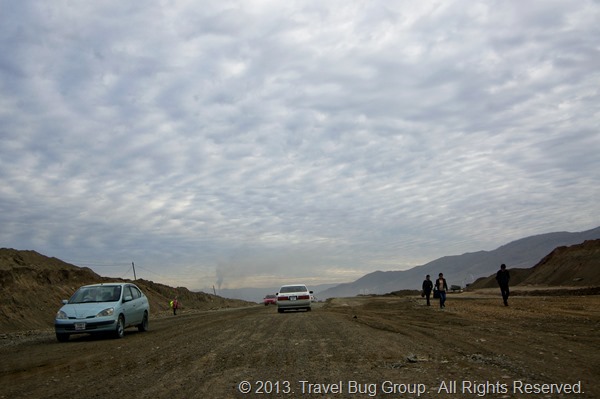
Our drive from the airport into Ulaanbaatar.
The State Department Store, where we stayed near, is a leftover from the Soviet era, the building blocky and gray and more practical than pretty as is most of the buildings in Ulaanbaatar. Inside, however, is a modern bustling mall, with big screen television and the softest cashmere apparel and a large advertisement blaring that the fashion brand, Mango, was set to arrive soon.
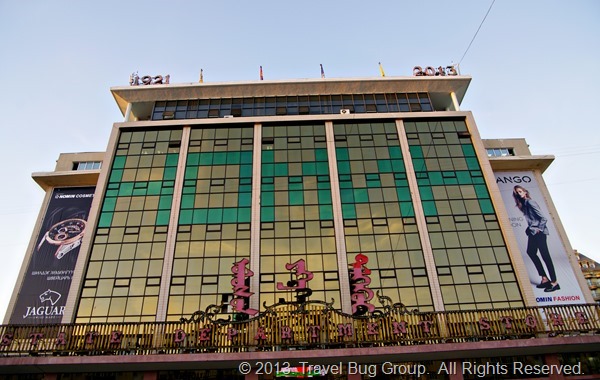
State Department Store. We went almost everyday since there’s a supermarket on the 1st floor & ATMs on the 5th.
Many restaurants run out of dishes or drinks in the middle of the day. It’s always good to have a back-up choice of dishes, as we’ll often point to something on the menu and have the waiter shake his heads. Though the exchange rate is good (approx. 1,600MNT to $1 the last time I checked), the prices are generally on par with American prices, good restaurants running around $20-$30 for a two-person dinner. The dishes are heavy on meat, fat, and starch to please the Central Asian palate and to account for the dearth of fresh fruits and vegetables especially now in the cold season. Rick and I usually get by on one large meal a day, and snacks the rest of the night. There are lots of Chinese and Korean restaurants around. However, our particular favorites are this chain of Mongolian Fast Food restaurants and Darjan Darbar, an Indian restaurant in the little cluster of restaurants & stores across the street from the State Department Store. At the Mongolian Fast Food, we love eating their buuz, meat dumplings the size of my palm, and khushur which are round fried pancakes stuffed with meat or a mix of mashed potatoes and shredded vegetables. I also love their meatball soup and Rick enjoys the fried sheep ribs, the meat arriving sizzling, thick layers of fat still clinging to them. No one drinks tap water here, so we bring our own water bottles with us to save some money or splurge on bottles of soda.
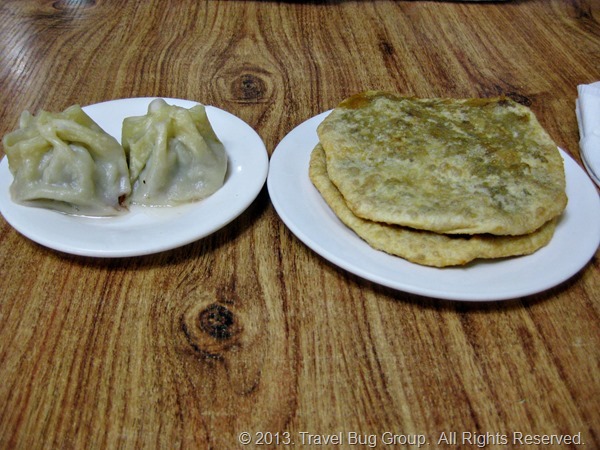
Buuz & Khushur
The people here can be standoffish to strangers, quick to stare, especially once they hear us speaking English. But, generally, they are friendly and helpful in a brusque manner. However, among each other, the Mongolian people are close, evident physically. The girls walk by with linked arms and boys pass by us, walking close enough to each other to brush shoulders, their mouths dipped close to each other in conversation. This is so different from puritanical America, where we constantly maintain a strict bubble of personal space around us, only breached by family or lovers.
The idea of Mongolia as a country on the edge between modern and traditional is evident in the way the people are dressed in Ulaanbaatar. Young people dress in the height of fashion. The girls, beautiful curvy girls with long black hair and pale skin, seem to favor a well-cut coat, flaring out at the waist, and skinny jeans or leggings tucked into sleek leather boots. The boys wear scarves and sunglasses with their jeans and jackets, fitted to their body, as they slouch down the street with panache. The oldest generation wear the traditional Mongolian garb, thick colorful tunics, belted at the waist and reaching down to their ankles, and it’s so strange to see them passing by the groups of chattering young people, as if I’m simultaneously seeing two time periods layered on top of the other.
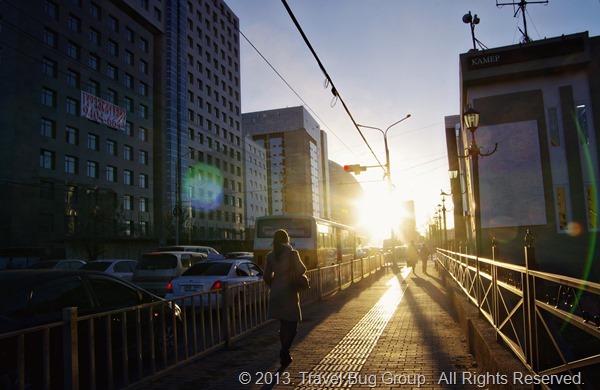
Looking down Peace Ave.
All age groups seem to favor home-grown music. Rick and I particularly like Mongolian rap, the rapid-fire words delivered with a particular rhythm inherent to the language. However, we did come across a group of schoolgirls gathered together at the local playground, practicing Rihanna’s "Diamonds in the Sky" song in clear lovely voices, an incongruous image that had me tripping off the curb. Plus, there’s a random memorial to the Beatles near Darjan Darbar. Also, equally surprising, is the interest in both basketball and chess here, to Rick’s delight. We see old men playing chess in the gardens off Sukbataar Square and sometimes we’ll pass by kids playing basketball in some sort of youth league or dressed in NBA basketball jerseys.
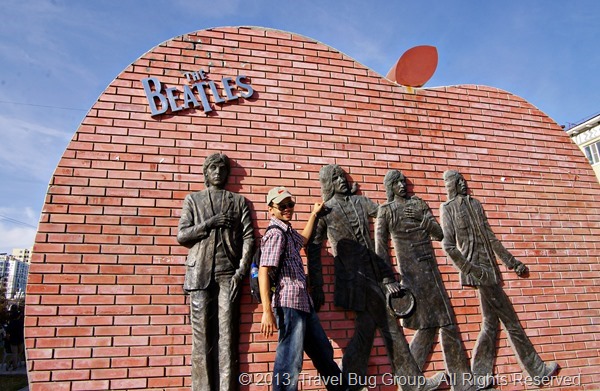
The Beatles Memorial
There’s only one main street that runs through Ulaanbaatar, Peace Avenue, and every other street stems from it. It’s difficult to get lost here, but equally as difficult to find the places we’re looking for. Though many of the larger streets have been given English names, the signs (what little signage we could find, usually posted on the walls of buildings) are still in Mongolian, no English translation. We navigate in a distinctly feminine manner, by landmarks, which irritates Rick to no end. In a crowd of people, there’s usually someone who can speak or read a few words of English as long as we’re patient enough to keep asking and searching. We’ve found great success using our Point It** book combined with sheer persistence.
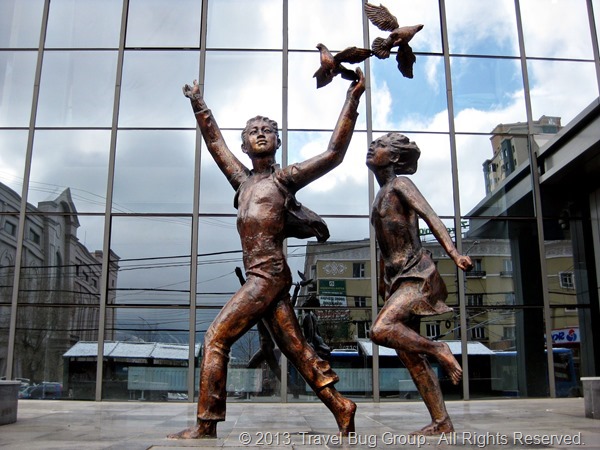
Sculpture in front of Peace Mall.
We chanced upon an art exhibit at 976 Gallery (5th floor of the Ramada Hotel on Peace Ave.) where the gallery owner was kind enough to explain a gorgeous painting by B. Nomin painted a few decades ago. "The artist," she said, "is showing how she feels that Mongolia has no way out, that there is chaos all over. Everyone is pretending." Perhaps that is the Mongolia from that time, but I feel that there are small doors opening up to the world now, leaking in outside influences. Whether that will be for the good or not, is up to the Mongolian people.
**Affiliate link
Leave a Reply